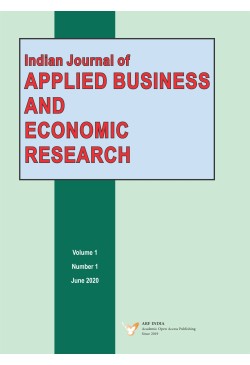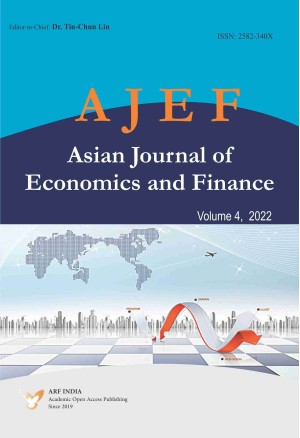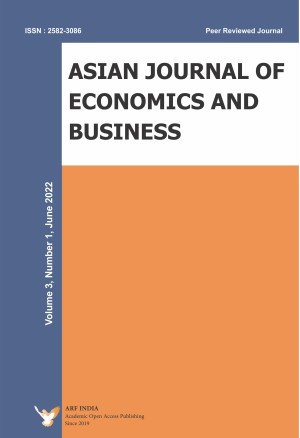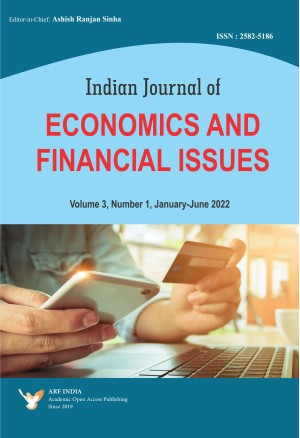MAKE MOST OF THE KNOWLEDGE NETWORK, JOIN ACADEMIC RESEARCH FOUNDATION
IJABERIndian Journal of Applied Business and Economic Research

Peer Reviewed Journal
Find out more
Latest Articles :- Vol: (6) (1) (Year:2025)
Unlocking Growth: The Impact of Land Reforms on Agricultural Productivity in the Russian Federation
BY: Nnanna P. Azu, Joseph. N. Igboneme and Ekaterina KlimakovaIndian Journal of Applied Business and Economic Research, Year:2025, Vol.6 (1), PP.1-19
Received: 19 December 2024 | Revised: 11 January 2025 | Accepted: 19 January 2025 | Publication: 16 February 2025
DOI : https://DOI:10.47509/IJABER.2025.v06i01.01
This study examines the impact of land reforms on agricultural productivity in the Russian Federation from 1991 to 2023 using the ARDL and NARDL estimation techniques. The analysis investigates the asymmetric effects of positive and negative changes in agricultural land on output growth, providing insights into the short- and long-term implications of land-use dynamics. The results indicate that positive changes in agricultural land have an insignificant impact on agricultural growth in the short and long run. In contrast, reductions in agrarian land exhibit a significant positive effect in the short term. The ARDL result suggests a positive impact of agricultural land on agro-economy growth in the short run. These findings suggest that land optimisation and efficiency improvements, rather than mere expansion, are critical to enhancing agricultural productivity. Drawing on the augmented neoclassical growth model, the study highlights the importance of aligning land reforms with technological investments, sustainable practices, and robust policy frameworks. Practical recommendations include strengthening land tenure systems, promoting efficient land use, and fostering innovation in the agricultural sector. The findings provide actionable insights for policymakers aiming to achieve sustainable growth in Russia's agricultural sector.
Keywords: Land Reform, Agricultural sector, Russia, economic growth, ARDL, NARDL
Nnanna P. Azu, Joseph. N. Igboneme & Ekaterina Klimakova (2025). Unlocking Growth: The Impact of Land Reforms on Agricultural Productivity in the Russian Federation. Indian Journal of Applied Business and Economic Research. 6(1), 1-19.
This study examines the impact of land reforms on agricultural productivity in the Russian Federation from 1991 to 2023 using the ARDL and NARDL estimation techniques. The analysis investigates the asymmetric effects of positive and negative changes in agricultural land on output growth, providing insights into the short- and long-term implications of land-use dynamics. The results indicate that positive changes in agricultural land have an insignificant impact on agricultural growth in the short and long run. In contrast, reductions in agrarian land exhibit a significant positive effect in the short term. The ARDL result suggests a positive impact of agricultural land on agro-economy growth in the short run. These findings suggest that land optimisation and efficiency improvements, rather than mere expansion, are critical to enhancing agricultural productivity. Drawing on the augmented neoclassical growth model, the study highlights the importance of aligning land reforms with technological investments, sustainable practices, and robust policy frameworks. Practical recommendations include strengthening land tenure systems, promoting efficient land use, and fostering innovation in the agricultural sector. The findings provide actionable insights for policymakers aiming to achieve sustainable growth in Russia's agricultural sector.
Keywords: Land Reform, Agricultural sector, Russia, economic growth, ARDL, NARDL
Nnanna P. Azu, Joseph. N. Igboneme & Ekaterina Klimakova (2025). Unlocking Growth: The Impact of Land Reforms on Agricultural Productivity in the Russian Federation. Indian Journal of Applied Business and Economic Research. 6(1), 1-19.
Financial Inclusion and Informality: Empirical Evidence in Ghana
BY: Abel FumeyIndian Journal of Applied Business and Economic Research, Year:2025, Vol.6 (1), PP.21-40
Received: 29 December 2024 | Revised: 27 January 2025 | Accepted: 30 January 2025 | Publication: 16 February 2025
DOI : https://DOI:10.47509/IJABER.2025.v06i01.02
This study examines the nexus between financial inclusion and informality in Ghana, leveraging data from the Ghana Living Standards Survey (GLSS7) and employing logistic regression techniques to determine demographic, social, economic and spatial factors that influence financial inclusion in the informal sector. The findings reveal significant gender disparities, with women being more likely to be financially inclusive than men. Regional variations indicate that financial inclusion is not uniformly distributed across the country, with some regions being more inclusive than others due to localised economic activities and access to financial services. The rural-urban divide plays a significant role in financial inclusion with urban areas being more inclusive than rural areas due to better access to financial services in the urban areas. Age, marital status, and level of education tend to strongly influence financial inclusion. The study emphasises the importance of leveraging technology, such as mobile banking and fintech solutions, to extend financial services to underserved areas and bridge the rural-urban divide. Policy suggestions include developing gender-specific financial products, implementing targeted financial education programs, and adopting regionalised strategies to address disparities.
Keywords: Financial Inclusion, Informality, logistic regression, Ghana.
JEL: C51, G21, G23, G44, G53
Abel Fumey (2025). Financial Inclusion and Informality: Empirical Evidence in Ghana. Indian Journal of Applied Business and Economic Research. 6(1), 21-40.
This study examines the nexus between financial inclusion and informality in Ghana, leveraging data from the Ghana Living Standards Survey (GLSS7) and employing logistic regression techniques to determine demographic, social, economic and spatial factors that influence financial inclusion in the informal sector. The findings reveal significant gender disparities, with women being more likely to be financially inclusive than men. Regional variations indicate that financial inclusion is not uniformly distributed across the country, with some regions being more inclusive than others due to localised economic activities and access to financial services. The rural-urban divide plays a significant role in financial inclusion with urban areas being more inclusive than rural areas due to better access to financial services in the urban areas. Age, marital status, and level of education tend to strongly influence financial inclusion. The study emphasises the importance of leveraging technology, such as mobile banking and fintech solutions, to extend financial services to underserved areas and bridge the rural-urban divide. Policy suggestions include developing gender-specific financial products, implementing targeted financial education programs, and adopting regionalised strategies to address disparities.
Keywords: Financial Inclusion, Informality, logistic regression, Ghana.
JEL: C51, G21, G23, G44, G53
Abel Fumey (2025). Financial Inclusion and Informality: Empirical Evidence in Ghana. Indian Journal of Applied Business and Economic Research. 6(1), 21-40.
Assessing the Dynamics of Geo-economics in Nepal: Implications for National Economic Security
BY: Dipak Raj LamichhaneIndian Journal of Applied Business and Economic Research, Year:2025, Vol.6 (1), PP.41-78
Received: 02 January 2025 | Revised: 28 January 2025 | Accepted: 05 February 2025 | Publication: 16 February 2025
DOI : https://DOI:10.47509/IJABER.2025.v06i01.03
Geo-economics integrates economic policies with political and geographical strategies to achieve national objectives. This study evaluates Nepal's geo-economics dynamics compared to India, the USA, China, SAARC, East Asia and Pacific, and Europe and Central Asia regions, using key variables like external debt, foreign direct investment, personal remittances, economic growth, and per capita income. Based on secondary data since 1995, the analysis reveals significant differences in Nepal's economic performance, especially in gross fixed capital formation and economic growth, leading to increased dependency on trade and remittance inflows. The study highlights the growing external debt and its potential to limit economic freedom and undermine national sovereignty. Nepal's weaker economic growth and current account balance are similar to India's, but its per capita GDP growth lags behind neighbouring economies due to historical macroeconomic challenges. The research emphasises that economic strength directly influences national security, with international politics and geography shaping Nepal’s geo-economics sovereignty.
Keywords: Geo-economics, neorealism, blockade, national economic security, rational actor
JEL Classification: O5; P51; P52;
Dipak Raj Lamichhane (2025). Assessing the Dynamics of Geo-economics in Nepal: Implications for National Economic Security. Indian Journal of Applied Business and Economic Research. 6(1), 41-78.
Geo-economics integrates economic policies with political and geographical strategies to achieve national objectives. This study evaluates Nepal's geo-economics dynamics compared to India, the USA, China, SAARC, East Asia and Pacific, and Europe and Central Asia regions, using key variables like external debt, foreign direct investment, personal remittances, economic growth, and per capita income. Based on secondary data since 1995, the analysis reveals significant differences in Nepal's economic performance, especially in gross fixed capital formation and economic growth, leading to increased dependency on trade and remittance inflows. The study highlights the growing external debt and its potential to limit economic freedom and undermine national sovereignty. Nepal's weaker economic growth and current account balance are similar to India's, but its per capita GDP growth lags behind neighbouring economies due to historical macroeconomic challenges. The research emphasises that economic strength directly influences national security, with international politics and geography shaping Nepal’s geo-economics sovereignty.
Keywords: Geo-economics, neorealism, blockade, national economic security, rational actor
JEL Classification: O5; P51; P52;
Dipak Raj Lamichhane (2025). Assessing the Dynamics of Geo-economics in Nepal: Implications for National Economic Security. Indian Journal of Applied Business and Economic Research. 6(1), 41-78.
Understanding Agricultural Household Risks: A Systematic Literature Review
BY: Chandrarathne WRPK, Perera DAM2 and Gamage SKIndian Journal of Applied Business and Economic Research, Year:2025, Vol.6 (1), PP.79-103
Received: 18 October 2024 | Revised: 25 December 2024 | Accepted: 10 January 2025 | Publication: 16 February 2025
DOI : https://DOI:10.47509/IJABER.2025.v06i01.04
The agricultural sector plays a fundamental role in economic development by supporting food security, employment, and income generation. Despite its importance, agriculture remains a high-risk sector due to exposure to various uncertainties. Recognising and understanding these risks is essential for farmers, financial institutions, insurers, policymakers, and other stakeholders to design effective risk management strategies and policies that support sustainable farming and resilience in agriculture. This literature review provides a comprehensive overview of the types and sources of risks encountered by agricultural households, synthesising insights from recent studies. Accordingly, the review aims (1) to identify and categorise the different types of risks affecting agricultural households, (2) to examine the primary sources of these risks, and (3) to analyse current trends and gaps in agricultural risk literature. A review of the 17 most relevant publications from 2013 to 2023 revealed seven primary categories of risks: weather and climate, production, financial, human or personal, property, price or market, and institutional risks. These risks were further grouped as internal risks those within the farmer's control, such as production and personal risks and external risks, like market and institutional factors beyond their control. The literature shows an emphasis on climate, production, and market risks, with property risk receiving less attention. Additionally, while risk sources are identified, they are not extensively analysed, highlighting an opportunity for deeper investigation. These findings underscore the need for targeted research on property and social risks and context-specific risk factors, contributing to informed policy and resilience-building in agricultural communities.
Keywords: Agricultural Risks, Risk Management, Sustainable Farming, Structural model.
Chandrarathne WRPK, Perera DAM & Gamage SK (2025). Understanding Agricultural Household Risks: A Systematic Literature Review. Indian Journal of Applied Business and Economic Research. 6(1), 79-103.
The agricultural sector plays a fundamental role in economic development by supporting food security, employment, and income generation. Despite its importance, agriculture remains a high-risk sector due to exposure to various uncertainties. Recognising and understanding these risks is essential for farmers, financial institutions, insurers, policymakers, and other stakeholders to design effective risk management strategies and policies that support sustainable farming and resilience in agriculture. This literature review provides a comprehensive overview of the types and sources of risks encountered by agricultural households, synthesising insights from recent studies. Accordingly, the review aims (1) to identify and categorise the different types of risks affecting agricultural households, (2) to examine the primary sources of these risks, and (3) to analyse current trends and gaps in agricultural risk literature. A review of the 17 most relevant publications from 2013 to 2023 revealed seven primary categories of risks: weather and climate, production, financial, human or personal, property, price or market, and institutional risks. These risks were further grouped as internal risks those within the farmer's control, such as production and personal risks and external risks, like market and institutional factors beyond their control. The literature shows an emphasis on climate, production, and market risks, with property risk receiving less attention. Additionally, while risk sources are identified, they are not extensively analysed, highlighting an opportunity for deeper investigation. These findings underscore the need for targeted research on property and social risks and context-specific risk factors, contributing to informed policy and resilience-building in agricultural communities.
Keywords: Agricultural Risks, Risk Management, Sustainable Farming, Structural model.
Chandrarathne WRPK, Perera DAM & Gamage SK (2025). Understanding Agricultural Household Risks: A Systematic Literature Review. Indian Journal of Applied Business and Economic Research. 6(1), 79-103.
An Assessment of the Impact of Industry 4.0 Technological Advances on Employment in India
BY: Amita Dharmadhikary-Yadwadkar and Ashwini PathakIndian Journal of Applied Business and Economic Research, Year:2025, Vol.6 (1), PP.105-126
Received: 06 January 2025 | Revised: 28 January 2025 | Accepted: 03 February 2025 | Publication: 16 February 2025
DOI : https://DOI:10.47509/IJABER.2025.v06i01.05
The Indian economy has seen the advent of the Industry 4.0 technological advancements in many sectors. Adoption of these new technologies is likely to impact employment. Some scholars see some potential adverse impact leading to unemployment whereas other scholars feel that it will bring about a creation of new jobs and a demand for newer skill sets. Given this, it is important to study and assess the net impact of Industry 4.0 changes on employment. In this paper, we have attempted to conceptualize and assess the possible impact of Industry 4.0 changes on employment in sectors like health, manufacturing and construction of the Indian economy, especially construction, which has not been studied much.
We find that the new emerging technologies will definitely create an impact in many of the large scale and capital-intensive industries and sectors.However, given the cost of adoption of these new technologies as well as adequate labour being available in India, it seems unlikely that these new technologies will be adapted in a major way in the small and medium scale industries so as to displace labour and create unemployment. Hence, the adverse impact of these new technologies on employment may only be marginal at this stage. However, we also conclude that if some of these technologies are adopted in a labour intensive sector like construction, some amount of unskilled labour could be displaced. The probability of adoption of these technologies in the construction sector cannot be ruled if the rental model emerges therein.
Keywords: Industry 4.0 Technology, Employment, Construction Sector, Labour Displacement, Rental Model.
JEL Classification Codes: O33 (Technological Change: Choices and Consequences), J23 Labour Demand, L74: Construction.
Amita Dharmadhikary-Yadwadkar & Ashwini Pathak (2025). An Assessment of the Impact of Industry 4.0 Technological Advances on Employment in India. Indian Journal of Applied Business and Economic Research. 6(1), 105-126.
The Indian economy has seen the advent of the Industry 4.0 technological advancements in many sectors. Adoption of these new technologies is likely to impact employment. Some scholars see some potential adverse impact leading to unemployment whereas other scholars feel that it will bring about a creation of new jobs and a demand for newer skill sets. Given this, it is important to study and assess the net impact of Industry 4.0 changes on employment. In this paper, we have attempted to conceptualize and assess the possible impact of Industry 4.0 changes on employment in sectors like health, manufacturing and construction of the Indian economy, especially construction, which has not been studied much.
We find that the new emerging technologies will definitely create an impact in many of the large scale and capital-intensive industries and sectors.However, given the cost of adoption of these new technologies as well as adequate labour being available in India, it seems unlikely that these new technologies will be adapted in a major way in the small and medium scale industries so as to displace labour and create unemployment. Hence, the adverse impact of these new technologies on employment may only be marginal at this stage. However, we also conclude that if some of these technologies are adopted in a labour intensive sector like construction, some amount of unskilled labour could be displaced. The probability of adoption of these technologies in the construction sector cannot be ruled if the rental model emerges therein.
Keywords: Industry 4.0 Technology, Employment, Construction Sector, Labour Displacement, Rental Model.
JEL Classification Codes: O33 (Technological Change: Choices and Consequences), J23 Labour Demand, L74: Construction.
Amita Dharmadhikary-Yadwadkar & Ashwini Pathak (2025). An Assessment of the Impact of Industry 4.0 Technological Advances on Employment in India. Indian Journal of Applied Business and Economic Research. 6(1), 105-126.



-300x438.JPG)
